
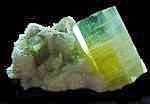
 |
 |
| Mining Operations at Mount Mica & Orchard Pit Mines, Oxford County, Maine. | |
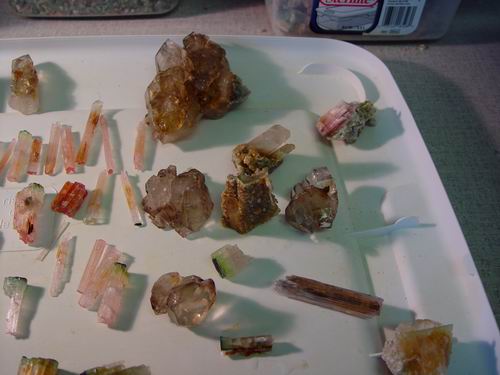
During the month of June and into the
first part of July we removed a seemingly endless quantity of
lepidolite from our drift. Each blast covered the floor in purple
chunks and white to pink hued spodumene fragments all of which we
picked up and stored. We designed our blasts to loosen as large of
pieces of the high quality lepidolite at possible. Once we
concluded that we had enough lepidolite, we turned our mining down dip
and away from this mass. This turn left the up dip side of our drift
purple as we worked ahead. Just to the down dip side of this lithia
mineral concentration, we encountered a very large area of feldspar
whose cracks had been infilled with löllingite. Always a worrier, I feared
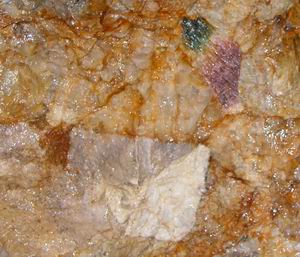 the
löllingite
was perhaps a harbinger of some untoward shift in the
mineralization. This area was also dominated
by very large rusty crack that led nearly on axis with the direction of
our drift. The crack had been evident for many meters but now seemed to
become larger. It was increasingly filled with a rusty and muddy
detritus. the
löllingite
was perhaps a harbinger of some untoward shift in the
mineralization. This area was also dominated
by very large rusty crack that led nearly on axis with the direction of
our drift. The crack had been evident for many meters but now seemed to
become larger. It was increasingly filled with a rusty and muddy
detritus. On the bright side, as we mined ahead, small vugs began to appear within the lepidolite as it became less massive and more vein like. Sizable locked in elbaites began showing up. This was somewhat reminiscent of the lithia mineral concentration we had encountered out in the main pit late in 2004. (See Mt. Mica, October 2004) Eventually a small pocket developed on the back of the lepidolite. This pocket was designated 10-05. It contents consisted of completely altered tourmaline and a mass of jumbled cookeite. A very large tourmaline had at one time extended into the pocket and it's red elbaite stump was still evident in the pocket wall. Pocket 10 actually was the beginning on a series of interconnected chambers that led both upstrike and down dip. Each of these chambers contained a few small quartz crystals and etched tourmaline fragments. All of us spent considerable time and effort trying to punch into a worthwhile space using chisels and our pneumatic chipping hammer. Spaces were many , results few. We were also encouraged to have exposed a huge pendant schorl on the right side of our drift. These were always a reliable pocket sign. Pocket 10 appeared to be radiating in that direction. With interest we noticed that each morning a sizable puddle had accumulated at the end of our drift. 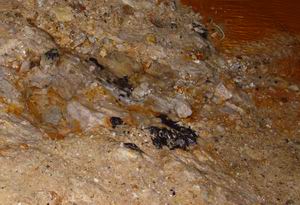 We were becoming fairly proficient at 2 meter advances, so we decided to make our next advance nearly 3 meters. With the successful completion the 3 meter burn , it was time to begin working the mineralized zone. We kept reassuring ourselves that big mineralization such as the lithia body we discovered portended big pockets. During the Maine Pegmatite Workshop visit in to Mt Mica in June, Al Falster suggested that we would probably find what we were looking for just beyond and down dip of this body. We were in silent agreement with him. The first bench only exposed more of the vugs associated with 10-5. On July 7 we began drilling our another bench into the pegmatite. While drilling the 3rd of 4 holes the drill dropped in a small cavity. Immediately water began pouring from this hole. Using the blowpipe, we attempted to assess the size of the cavity by forcing out the water with compressed air. The water continued regardless of the amount of air we pumped in. A small cavity would have been immediately blown dry. We had been around this block before. As we approached pocket 28-04 we also released a flow of water. The next morning , as we did with pocket 28-04, we measured the amount of accumulated water. The rate was determined to be 500 gallons/day. This flow was to continue undiminished for 2 weeks. Based on the water flow, we were on the trail of a cavity at least 100 m3 using the flow from 28-04, a 40m3 pocket, as a baseline. However, we spent the next two weeks trying to locate it without success. What we did find was an increasingly large series of chambers which seemed to be only
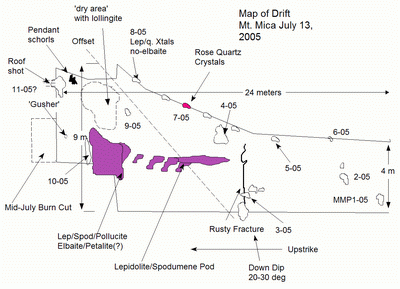 have negative implications for our
mining on several levels. As we widened our burn to
towards the area of the pendant schorl shown in the image above, we did encounter a
sizable cavity. Its contents were similar to the material of pocket 10
but it was large enough to insert our standard unit of measure, a hoe
handle. Unfortunately, at this point, I was recalled to Florida for 2
weeks. In the interim Richard and Jim would make another advance. We
were convinced we were getting close to our 'objective', a pocket on
the scale of our mineralization. We hoped the next advance would get us
to where we wanted to be. have negative implications for our
mining on several levels. As we widened our burn to
towards the area of the pendant schorl shown in the image above, we did encounter a
sizable cavity. Its contents were similar to the material of pocket 10
but it was large enough to insert our standard unit of measure, a hoe
handle. Unfortunately, at this point, I was recalled to Florida for 2
weeks. In the interim Richard and Jim would make another advance. We
were convinced we were getting close to our 'objective', a pocket on
the scale of our mineralization. We hoped the next advance would get us
to where we wanted to be. In my absence, Jim and Richard completed the new 3m burn. The pegmatite drilled so softly they both fully expected to drill into a pocket at any moment. When I returned, we picked up again exploring the cavity at the far right for our drift. Much of it was still in the floor. As we exposed it further, it became clear, that as it worked it way into the headwall of the drift, it was becoming larger. We decided at that point it would be worth the effort to try to expose the pocket further by drilling a few holes into its roof. As the pocket was essentially at our feet, working the way it was was strictly an on your belly operation. To this point, it was still producing only opaque tourmalines a 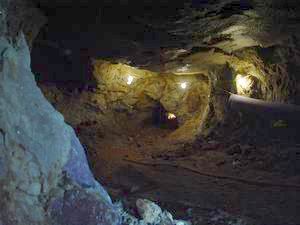 nd
uninteresting quartz crystals. The (3) 1m holes, which we drilled in
the roof
in an arch like pattern, pulled well and produced an
amazing amount of of muck. It was mostly shattered quartz, which
required several hours of hand mucking with shovels and hoes to clear
from the expanded yet still narrow space we had created. Once we mucked
it
out, we could see that there was another chamber behind the one
we
had enlarged. With a little handwork we were able to get a better look
into this space. On the very top of the pocket lay pieces of bright
pink tourmaline with dark blue and dark green caps. These were unlike
any of the other material we had seen from these cavities. All the
pieces were quite gemmy and exhibited a definite fiber optic light
piping quality. Illuminated from the ends, light emerged from the
opposite end with a bright pink intensity no matter how long the piece.
In this cavity we also found our first quartz crystals with overgrowth
We were also now finding small gemmy green tourmalines too.. ( see the picture at the top
of the page) In the
image to the right, the pocket can be seen near the
center. A light in the pocket illuminates another chamber. nd
uninteresting quartz crystals. The (3) 1m holes, which we drilled in
the roof
in an arch like pattern, pulled well and produced an
amazing amount of of muck. It was mostly shattered quartz, which
required several hours of hand mucking with shovels and hoes to clear
from the expanded yet still narrow space we had created. Once we mucked
it
out, we could see that there was another chamber behind the one
we
had enlarged. With a little handwork we were able to get a better look
into this space. On the very top of the pocket lay pieces of bright
pink tourmaline with dark blue and dark green caps. These were unlike
any of the other material we had seen from these cavities. All the
pieces were quite gemmy and exhibited a definite fiber optic light
piping quality. Illuminated from the ends, light emerged from the
opposite end with a bright pink intensity no matter how long the piece.
In this cavity we also found our first quartz crystals with overgrowth
We were also now finding small gemmy green tourmalines too.. ( see the picture at the top
of the page) In the
image to the right, the pocket can be seen near the
center. A light in the pocket illuminates another chamber. Go to Page: 2, 3, 4 |